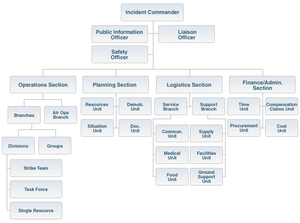Mass casualty incident
Background
Potential Causes of MCI
Mass casualty incident
- Radiation exposure (disaster)
- Dirty bomb
- Bioterrorism
- Chemical weapons
- Mass shooting
- Natural Disaster (e.g. Hurricane, Earthquake, Tornado, Tsunami, etc)
- Unintentional large-scale incident (e.g. building collapse, train derailment, etc)
- Major pandemic
- Explosions
Management

ICS Organization Structure
Initial Triage
Incident Command System (ICS)
- An Incident Command System (ICS) is designed to allow for coordination of response to an MCI by providing for an integrated organizational/command structure[3]
- ICS has been in use since the 1970's.
- Designed to expand or contract in size in response to scope of incident.
- After the September 11, 2001 terrorist attacks, the Department of Homeland Security proposed the National Incident Management System (NIMS) in response to perceived deficiencies in coordination between emergency responders.[4]
- NIMS mandates the use of ICS in the United States for MCI response[3]
External Links
References
- Briggs SM. Disaster management teams. Curr Opin Crit Care. 2005 Dec;11(6):585-9.
- Lee JS, Franc JM. Impact of a Two-step Emergency Department Triage Model with START, then CTAS, on Patient Flow During a Simulated Mass-casualty Incident. Prehosp Disaster Med. 2015 Jun 24:1-7.
- FEMA IS 0100.b - Introduction to the Incident Command System (ICS), Student Manual. http://training.fema.gov/emiweb/is/is100b/student%20manual/02ics100b_sm_october2013.pdf. Accessed 07/24/2015.
- Jensen J, Youngs G. Explaining implementation behaviour of the National Incident Management System (NIMS). Disasters. 2015 Apr;39(2):362-88. doi: 10.1111/disa.12103.
This article is issued from
Wikem.
The text is licensed under Creative
Commons - Attribution - Sharealike.
Additional terms may apply for the media files.